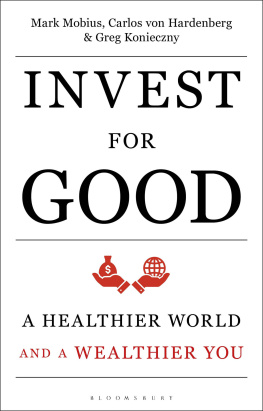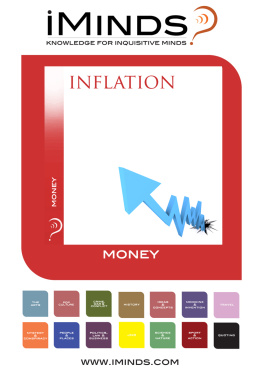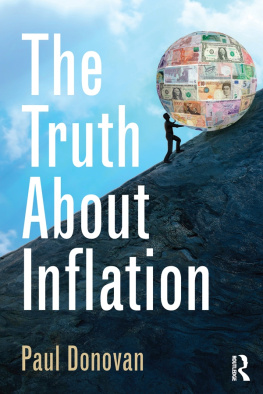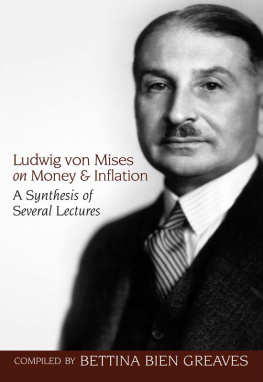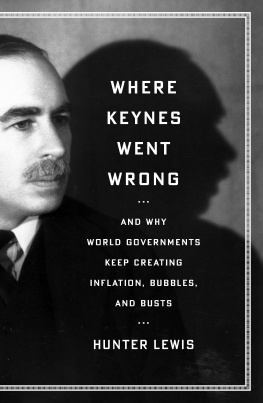
Table of Contents
List of Tables
- Chapter 8
List of Illustrations
- Chapter 8
Guide
Pages
The Inflation Myth
AND THE WONDERFUL WORLD OF DEFLATION
By Mark Mobius

This edition first published 2021
2021 Mark Mobius
Originally published in German as "Die Wahrheit ber Inflation: Warum Geldentwertung jeden etwas angeht, wie sie manipuliert wird und wie man es durchschaut" 2019 Mark Mobius
Registered office
John Wiley & Sons Ltd, The Atrium, Southern Gate, Chichester, West Sussex, PO19 8SQ, United Kingdom
For details of our global editorial offices, for customer services and for information about how to apply for permission to reuse the copyright material in this book please see our website at www.wiley.com.
All rights reserved. No part of this publication may be reproduced, stored in a retrieval system, or transmitted, in any form or by any means, electronic, mechanical, photocopying, recording or otherwise, except as permitted by the UK Copyright, Designs and Patents Act 1988, without the prior permission of the publisher.
Wiley publishes in a variety of print and electronic formats and by printondemand. Some material included with standard print versions of this book may not be included in ebooks or in printondemand. If this book refers to media such as a CD or DVD that is not included in the version you purchased, you may download this material at http://booksupport.wiley.com. For more information about Wiley products, visit www.wiley.com.
Designations used by companies to distinguish their products are often claimed as trademarks. All brand names and product names used in this book are trade names, service marks, trademarks or registered trademarks of their respective owners. The publisher is not associated with any product or vendor mentioned in this book.
Limit of Liability/Disclaimer of Warranty: While the publisher and author have used their best efforts in preparing this book, they make no representations or warranties with respect to the accuracy or completeness of the contents of this book and specifically disclaim any implied warranties of merchantability or fitness for a particular purpose. It is sold on the understanding that the publisher is not engaged in rendering professional services and neither the publisher nor the author shall be liable for damages arising herefrom. If professional advice or other expert assistance is required, the services of a competent professional should be sought.
Library of Congress CataloginginPublication Data
Names: Mobius, Mark, author. Title: The inflation myth and the wonderful world of deflation / by Mark Mobius. Description: Hoboken, NJ : Wiley, 2021. | Includes index. Identifiers: LCCN 2020020072 (print) | LCCN 2020020073 (ebook) | ISBN 9781119741428 (hardback) | ISBN 9781119741497 (ePDF) | ISBN 9781119741527 (ePub) Subjects: LCSH: Inflation (Finance) | Deflation (Finance) | Pricing. Classification: LCC HG229 .M73 2021 (print) | LCC HG229 (ebook) | DDC 332.4/1dc23 LC record available at https://lccn.loc.gov/2020020072LC ebook record available at https://lccn.loc.gov/2020020073
Cover Design: Wiley
Set in 13/17pt Adobe Garamond Pro by SPi Global, Chennai, India
This book is dedicated to all of the people I haveworked with in capital markets over the years.Many inspired me with new ideas and innovativeconcepts, laying the ground for me to think creativelyand embark on new adventures.
PREFACE
Shortly after this manuscript was handed into my publishers in early 2020, the COVID19 outbreak shook the world and changed life as we knew it. From one day to the next, hundreds of thousands of lives were at stake and our economic systems came to a halt as governments around the world entered into unprecedented shutdowns.
In the wake of the COVID19 crisis, we witnessed a lot of speculation about global economies slipping into recession. This, in turn, was expected to lead to a deflationary environment driven by weakening growth and demand. As a result of the crisis, we witnessed shortterm price fluctuations in stock and bond markets all over the world.
However, the argument of this book is focused on the longer term trends regarding the rise and fall of economies and market.
I believe we have been putting too much weight on inflation statistics which are for a variety of reasons faulty. Despite economic slowdowns caused by various crises over the years advances in technology and automation are leading to continuously falling costs for goods and services. At the same time, a wave of completely new products enters the consumer stage every year, improving lives around the world. On example of how technology is reducing costs is the conference call service provided by Zoom Communications; users of their conference app dramatically increased from 10 million per day in December of 2019 to 300 million per day by April 2020. Many of these new users were using the free Zoom version, as opposed to the premium one, so paying nothing for a service that would have cost hundreds if not thousands of dollars in telephone bills just 10 or 20 years previously. To accurately depict this phenomenon of constant technological innovation in inflation statistics is at best challenging, if not impossible, as this book will show.
Another argument of this book is that the basket of goods and services which forms the basis of the CPI (Consumer Price Index) calculation is continuously changing, so the basket of 1900 is different from the one in 1950, and the one in 1950 is different from the one in 2000. The problem is that you are comparing different baskets of goods and services, thus rendering any comparison somewhat meaningless. Furthermore, with consumption patterns constantly changing, the basket is always a step behind when it comes to tracking typical spending patterns.
Over the years we have seen farreaching changes in the way people work, shop, and spend their time. This in turn has led to significant changes in spending patterns and, in some cases, rapid price changes. Certain goods have disappeared from shelves and many services are no longer provided. So, calculations based on the old basket no longer reflect changes in the consumer welfare of a typical person, as typical consumer behavior has changed.
If inflation statistics do not accurately reflect the changes in peoples' welfare, then it does not make sense to stick to inflation targets. By 2020, central banks were learning this the hard way as their financial tools were proving less and less effective in influencing inflation numbers. What we need to recognize is the necessity of questioning the holy grail of inflation targeting and rethinking an approach that we have been following almost blindly for a long time.
This book aims to help unravel the Myth of Inflation and to provide some food for thought on the future of the inflation policies that are significantly impacting our everyday lives around the world. More importantly I want to demonstrate that, in fact, we are in a deflationary world with goods and services improving in quality and variety while declining as a percent of people's incomes.
INTRODUCTION
Inflation has been a subject for bankers, scholars, political leaders, and the general public for a long time. The rising prices of goods and services in currency terms have been condemned by people since time immemorial. There has been no letup in everyone's desire to stop prices from rising, despite governments' continual actions to debase their currencies.
Next page

